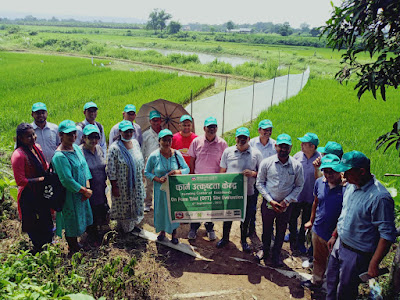Farmers, consumers, rice-based agri-food system stakeholders, and, ultimately, Nepal’s national economy would benefit from the faster adoption of new climate-resilient, high-yielding rice by the country’s farmers. To facilitate the adoption of new rice varieties, the International Rice Research Institute (IRRI), Nepal Agriculture Research Council, Agriculture and Forestry University, Agriculture Knowledge Centers, and the Prime Minister Agriculture Modernization Program arranged a field visit and roundtable discussion on 6 September 2022 in Chitwan.
IRRI also tapped a number of private seed companies and farmers’ cooperatives for the event that aimed to position new rice varieties in target markets through on-farm testing and their value creation through product profiling as part of a more effective varietal marketing strategy.
A team of 26 people representing farmers, researchers, university faculty, public extension agents, and private seed companies participated in the on-farm trials for wet-season rice that included mostly newly released climate-resilient rice varieties as well as the forthcoming zinc biofortified rice.
“Nepal really needs to fast track delivery of new genetic gains to farmers’ fields to strengthen domestic rice production to meet the shortfall of large quantities of rice,” said Krishna Dev Joshi, a seed system specialist and IRRI Country Representative for Nepal.
In the last decade, Nepal has released 16 stress-tolerant varieties developed from IRRI rice germplasm. However, the adoption of these new varieties by Nepalese farmers remains slow. In comparison, several of the same rice varieties released in other countries in South Asia are making faster headway.
“The most popular rice varieties in Nepal are mostly 30-40 years old,” Dr. Joshi said. “This is because these have established value chains- both seed and grain value chains. This is the major hurdle to delivering new rice varieties to farmers’ fields quickly.”
Key actors of value chains such as seed companies and rice millers are reluctant to entertain newly released varieties all of a sudden due to lack of knowledge and demand for such products by consumers, according to him. Secondly, the extra cost for marketing new products discourages the interest of the private sector.
“The engagement of private sector seed companies for on-farm testing has already been done in Nepal and can be an effective tool,” Dr. Joshi said. “The farmers and seed companies who attended the event were enthusiastic and keen to access the seeds of the featured varieties as soon as possible.”
The team also monitored on-going trials for short- and medium-duration rice varieties, mostly germplasm from IRRI and the project Accelerating Genetic Gains in Rice (AGGRi), at the Research Station of Agriculture and Forestry University. Two to three elite lines from the AGGRi trials have excellent performance and may be released within a year or two.
Swati Nayak, IRRI South Asia Lead for Seed Systems and Product Management discussed strategies for delivering improved rice varieties to farmers at a faster rate with the 35 participants in the roundtable discussion.
“Positioning of new rice varieties in the target markets using on-farm trials is a powerful tool for farmers to compare new and existing rice varieties on their farms using their management,” Dr. Nayak said. “A one-page product profile of all the rice varieties should be given to farmers collaborating in on-farm trials.”
A one-page product profile contains vital information on test varieties, their suitable target markets, how new varieties compare with popular rice varieties, benchmark checks as well as other possible alternative varieties if a specific variety does not perform well or not accepted by the farmers. Dr. Nayak said that Bangladesh Rice Research Institute and the Bangladesh Institute of Nuclear Agriculture have already institutionalized the strategy which has been very effective. Similarly, the approach is also becoming increasingly popular in India, particularly with agriculture science centers known as Krishi Vigyan Kendras.
“On-farm trials, product profiling and market positioning are also very instrumental in bridging the major gaps between research and extension,” Dr. Nayak added. She also highlighted that on-farm trials offer season-long experiential learning to farmers and all other stakeholders involved in the process. Participants from Muktinath Krishi, a private seed company, showed keen interest in adopting the tool in the country as soon as possible.
Nepal falls short of meeting domestic demand for rice every year and imports large quantities of rice from India and other countries. The predominant use of old varieties, sub-optimal agricultural practices, and the climate crisis are largely blamed for the country’s meager productivity of its agriculture, including the rice sector. This year's global economic crisis also added to the already complex problem.
Participants appreciated IRRI’s effort for organizing such a productive event and suggested organizing several such events at regular intervals to create momentum for fast delivery of improved rice varieties to farmers’ fields.
###





No comments:
Post a Comment